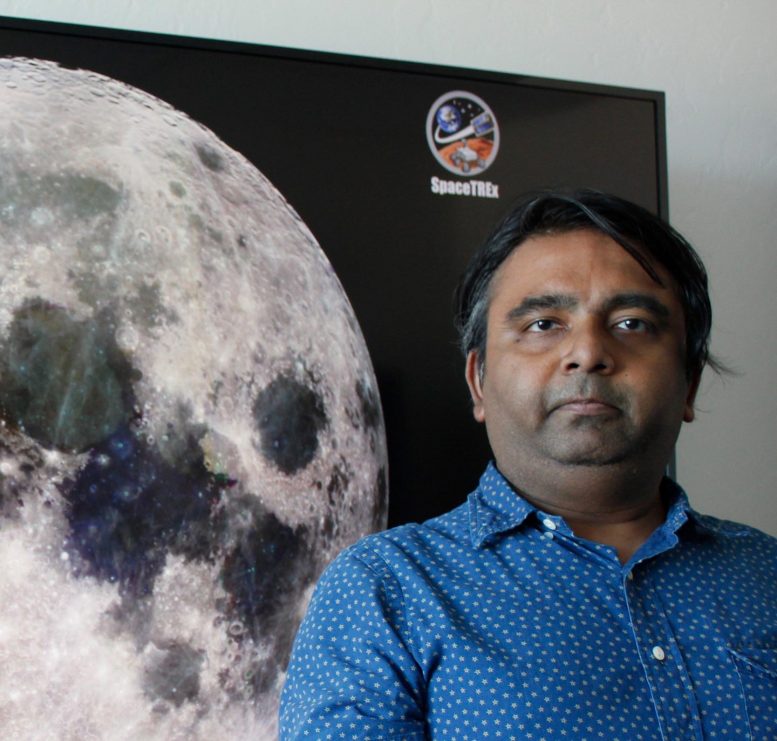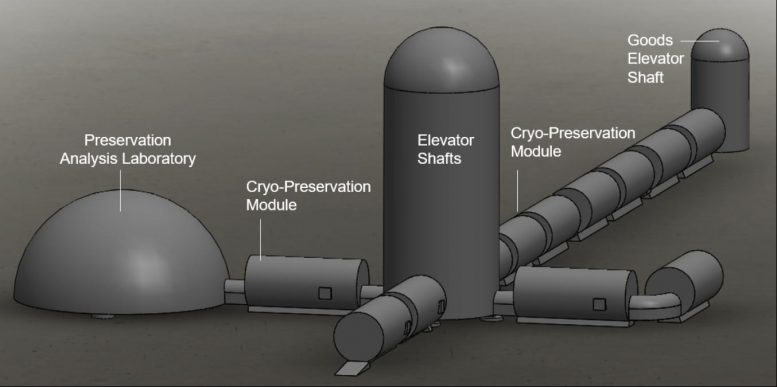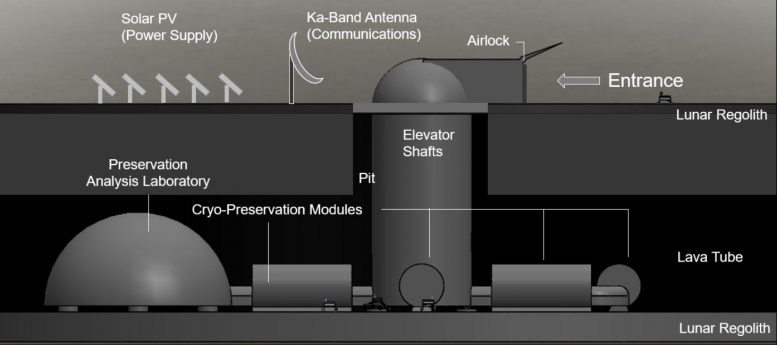The ambitious project proposed by a University of Arizona team aims to preserve humankind – and animal-kind, plant-kind and fungi-kind – in the event of a global crisis.
University of Arizona researcher Jekan Thanga is taking scientific inspiration from an unlikely source: the biblical tale of Noah’s Ark. Rather than two of every animal, however, his solar-powered ark on the moon would store cryogenically frozen seed, spore, sperm and egg samples from 6.7 million Earth species.
Thanga and a group of his undergraduate and graduate students outline the lunar ark concept, which they call a “modern global insurance policy,” in a paper presented over the weekend during the IEEE Aerospace Conference (see video below).
“Earth is naturally a volatile environment,” said Thanga, a professor of aerospace and mechanical engineering in the UArizona College of Engineering. “As humans, we had a close call about 75,000 years ago with the Toba supervolcanic eruption, which caused a 1,000-year cooling period and, according to some, aligns with an estimated drop in human diversity. Because human civilization has such a large footprint, if it were to collapse, that could have a negative cascading effect on the rest of the planet.”
Climate change, he added, is another concern: If sea levels continue to rise, many dry places will go underwater – including the Svalbard Seedbank, a structure in Norway that holds hundreds of thousands of seed samples to protect against accidental loss of biodiversity. Thanga’s team believes storing samples on another celestial body reduces the risk of biodiversity being lost if one event were to cause total annihilation of Earth.
Totally Tubular
Scientists discovered a network of about 200 lava tubes just beneath the moon’s surface in 2013. These structures formed billions of years ago, when streams of lava melted their way through soft rock underground, forming underground caverns. On Earth, lava tubes are often similar in size to subway tunnels, and can be eroded by earthquakes, plate tectonics and other natural processes. This network of lunar lava tubes are about 100 meters in diameter. Untouched for an estimated 3 billion to 4 billion years, they could provide shelter from solar radiation, micrometeorites and surface temperature changes.
The idea of developing a lunar base, or human settlement on the moon, has been around for hundreds of years, and the lava tube discovery renewed the space community’s enthusiasm for the concept. But the moon isn’t exactly a hospitable environment where humans can spend extended periods. There isn’t water or breathable air, and it’s about minus 25 degrees Celsius, or minus 15 degrees Fahrenheit. It’s also not a very eventful place.
On the other hand, those same features make it a great place to store samples that need to stay very cold and undisturbed for hundreds of years at a time.
Building a lunar ark is no small undertaking, but, based on some “quick, back-of-the-envelope calculations,” Thanga said it’s not as overwhelming as it may sound. Transporting about 50 samples from each of 6.7 million species would require about 250 rocket launches. It took 40 rocket launches to build the International Space Station.
“It’s not crazy big,” Thanga said. “We were a little bit surprised about that.”
Cryogenics and Quantum Levitation
The mission concept builds on another project Thanga and his group previously proposed, in which miniature flying and hopping robots called SphereX enter a lava tube in teams. There, they would collect samples of regolith, or dust and loose rock, and gather information about the layout, temperature and makeup of the lava tubes. This information could inform the construction of the lunar base.
The team’s model for the underground ark includes a set of solar panels on the moon’s surface that would provide electricity. Two or more elevator shafts would lead down into the facility, where petri dishes would be housed in a series of cryogenic preservation modules. An additional goods elevator shaft would be used to transport construction material so that the base can be expanded inside the lava-tubes.

Jekan Thanga, professor of aerospace and mechanical engineering at the University of Arizona. Credit: University of Arizona
To be cryopreserved, the seeds must be cooled to minus 180 C (minus 292 F) and the stem cells kept at minus 196 C (minus 320 F). As a reference for just how cold this is, the Pfizer COVID-19 vaccine must be stored at minus 70 C, or minus 94 F. The fact that the lava tubes are so cold, and the samples must be even colder, means there’s a risk the metal parts of the base could freeze, jam or even cold-weld together. On Earth, commercial airlines stop working when ground temperatures reach minus 45 to minus 50 C (minus 49 to minus 58 F).
However, there’s a way to take advantage of the extreme temperatures by using an otherworldly phenomenon called quantum levitation (see video below). In this process, a cryo-cooled superconductor material – or a material that transfers energy without losing any heat, like a traditional cable does – floats above a powerful magnet. The two pieces are locked together at a fixed distance, so wherever the magnet goes, the superconductor follows.
“It’s like they’re locked in place by strings, but invisible strings,” Thanga said. “When you get to cryogenic temperatures, strange things happen. Some of it just looks like magic but is based on tried and laboratory-tested physics principles at the edge of our understanding.”
The team’s ark design uses this phenomenon to make the shelves of samples float above metal surfaces and have robots navigate through the facility above magnetic tracks.
There is much more research to be done on how to build and operate the ark, from investigating how the preserved seeds might be affected by a lack of gravity to fleshing out a plan for base communications with Earth.
“What amazes me about projects like this is that they make me feel like we are getting closer to becoming a space civilization, and to a not-very-distant future where humankind will have bases on the moon and Mars,” said Álvaro Díaz-Flores Caminero, a UArizona doctoral student leading the thermal analysis for the project. “Multidisciplinary projects are hard due to their complexity, but I think the same complexity is what makes them beautiful.”











They don’t explicitly describe what kind of apocalypse would make the inhabitants of Earth unable to protect or preserve life as is proposed for the lunar ‘Ark.’
However, if things get so dire on Earth that everyone and everything is in danger of dying, just who is going to build and launch another 250 space ships to retrieve the contents of the ‘Ark?’ Who is going to oversee the fertilization and maintenance of the embryos, and planting and watering of seeds? Would the undefined apocalypse make it impossible for the life forms to thrive if the original forms cannot?
I’m afraid that these dreamers haven’t thought this through!
“This network of lunar lava tubes are about 100 meters in diameter.”
Is the network 100 meters in diameter (small) or are the tubes themselves 100 meters in diameter (large).
By the way, I saw the same sentence in another article, and came to this one for clarification. The two articles share much identical text, and I didn’t get what I was looking for.
The world is spending vast sums of money with little real need to know. Mars isn’t teaming with life. The moon might provide minerals we might someday need. Not today.
So why not use all these resources to fix what needs to be fixed on earth? End poverty, end famine, defeat cancer and other diseases etc. etc. The list goes on and on. Why are we wasting so much money when only the ultra rich will benefit. They aren’t paying the bill.
Michael
I agree that there are lots of problems here on Earth. However, your basic assumptions are that all of them can be solved by just spending money, and there is sufficient money to address them all. Many of the problems are beyond the reach of our political borders and are often the result of cultural differences. Should we step in and stop the suffering and starvation in Venezuela just because it we can?
It is sometimes pointed out that Americans spend more on pet food than we do on the space program.
It isn’t obvious to me how the “ultra rich” are the benefactors of space exploration. At the moment, it seems that the main benefactors are academic researchers who have jobs as a result of designing instrumentation and analyzing results. Engineers, technicians, and the corporate infrastructure support-staff have jobs because of NASA contracts. These are mostly upper middle-class, NOT “ultra rich.”
As to who is paying the bill:
“In 2017, the bottom 50 percent of taxpayers (those with AGI below $41,740) … paid $49.8 billion in taxes, or roughly 3 percent of all federal individual income taxes in 2017.
In contrast, the top 1 percent of all taxpayers (taxpayers with AGI of $515,371 and above) earned 21.0 percent of all AGI in 2017 and paid 38.5 percent of all federal income taxes.
In 2017, the top 1 percent of taxpayers accounted for more income taxes paid than the bottom 90 percent combined. The top 1 percent of taxpayers paid roughly $616 billion, or 38.5 percent of all income taxes, while the bottom 90 percent paid about $479 billion, or 29.9 percent of all income taxes.”
The above is from:
https://taxfoundation.org/summary-of-the-latest-federal-income-tax-data-2020-update/#_ftn1
This ignores the contribution of corporate taxes to the federal treasury.
I agree with another comment that this sounds like a lot of ‘front end’ planning with painfully little ‘back end’ or execution planning. In many respects, getting samples from millions of earth species up to the moon and into cold storage is the *easy* part.
Who will be there to ‘activate’ the ark in case of emergency? Who will raise the portion of the 6.7 million species that possess conscious intelligent life (and, no, I’m not just talking about humans). Do we even possess the technology at this point to reliably bring them ‘back to life’ from a few cells in a petri dish and precious little else? Even if we did, once they are ‘born’, where would they live now that the very diverse yet delicate conditions and planet they evolved on assumptively no longer exist and/or can’t support life? Who would raise and/or care for them? (Even if people are still around, many people struggle with properly raising a dog or cat. Do YOU know how to raise a chimp? What about a raccoon, squirrel, or deer? Snakes, big cats, or bears? Chinook salmon, dolphins, or whales?… not to be domesticated and human dependent, but their natural selves with the wild instincts and knowledge passed down by generations of their kin? What would they eat or consume to sustain themselves? What about waste disposal? Agin, where would all these species live? Back on a planet Earth that’s had thousands or millions of years to renew itself and probably evolve new native species? Any other planet capable of supporting the diverse live of earth would almost certainly have its own native species, which may or may not be hostile to the idea or reality of 6.7 million new and very diverse types of neighbors.)
Until or unless we find answers to these pressing questions, perhaps it’s more prudent to use what resources we have to protect and preserve planet earth to the greatest degree possible, rather than falling prey to the logical fallacy that we can successfully store all earthly life on a shelf, reanimate it as needed, and that necessary steps to do so are not ‘crazy big’ or ‘overwhelming’.
If Dr Who ever comes back in a less woke shape I could see a future Tom Baker like Dr Who visiting the arc with Sarah Jane long after the earth habitat has died, he’d have something interesting to say about it too.
Spend the money on planetary robots to visit some of the giant planet’s moons would be more valuable to us now.